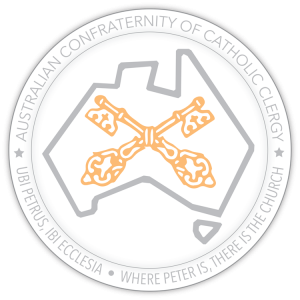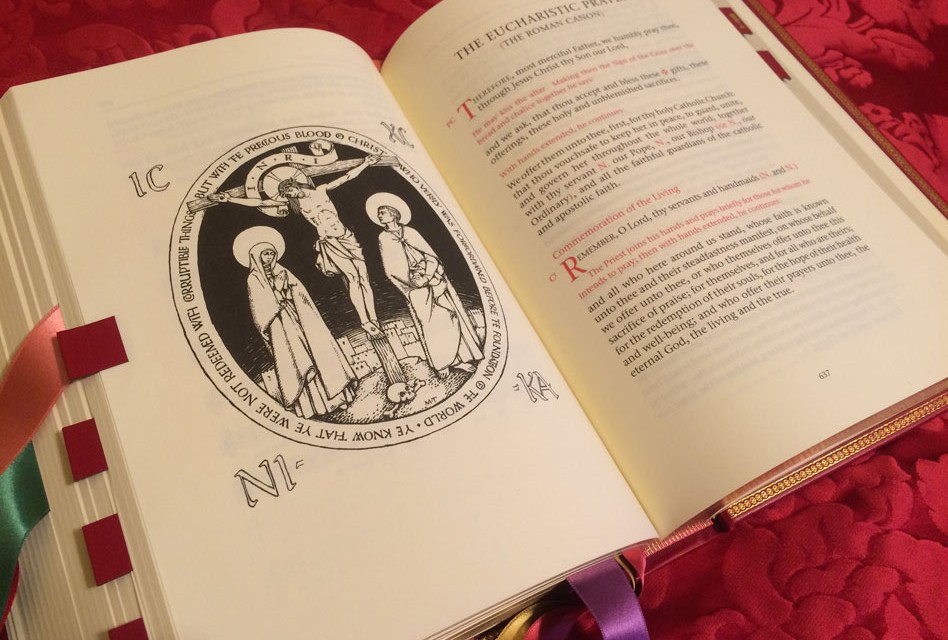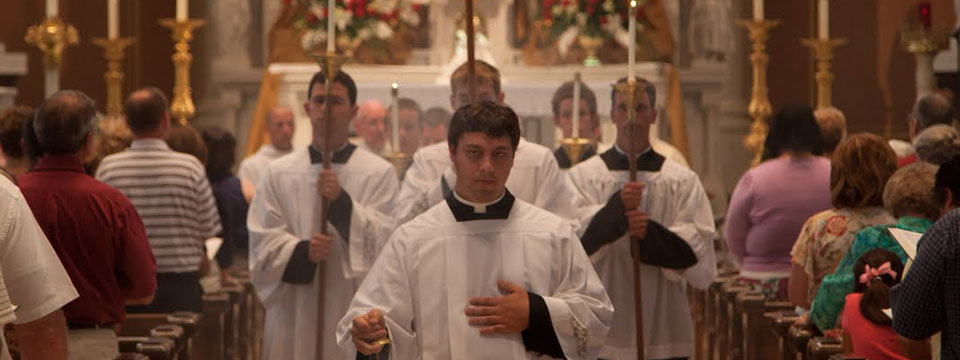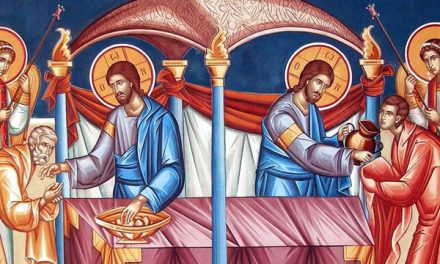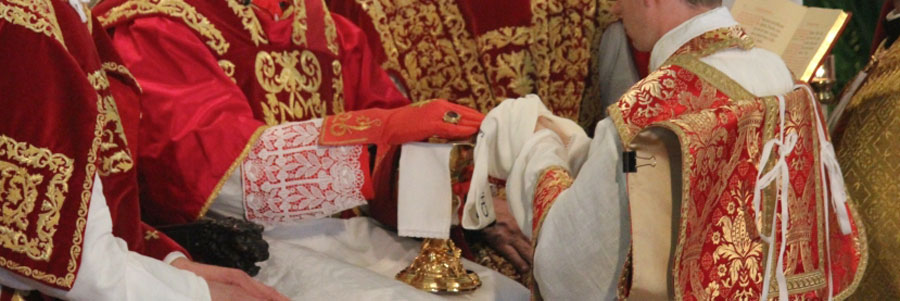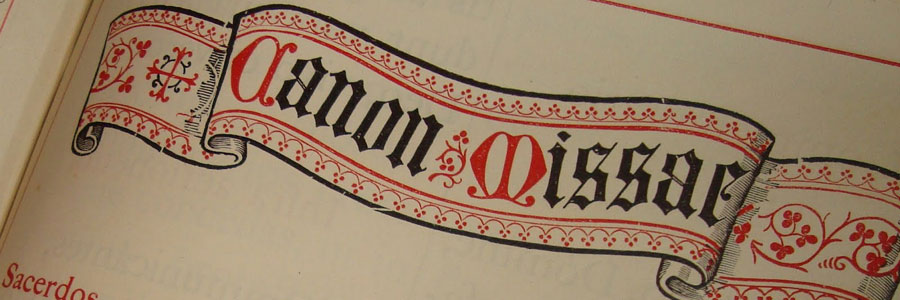On the First Sunday of Advent this year (29 November 2015), a new Missal of the Catholic Church was used for the first time in parishes of the Ordinariates in Australia, the United Kingdom and the United States and Canada. It was an historic occasion with radical ecumenical implications.
The new Missal, called Divine Worship – The Missal, is remarkable in that its texts are largely drawn from the Book of Common Prayer and the Anglican tradition or ‘patrimony’. It contains the Order for the Mass, and the variable prayers and other scriptural texts, instructions and rubrics and music, and the liturgical calendar for Ordinariate congregations.
Print Friendly Format
Download and view this article as it appeared in the Summer 2015 issue of The Priest.
Anglicanorum Coetibus
Pope Benedict XVI established the Ordinariates by Papal Constitution in 2009. Anglicanorum Coetibus was a response to requests from Anglicans worldwide wishing to return to the rock from which Anglicanism was originally hewn, without losing their identity or liturgical heritage. It was a pastoral and ecumenical initiative, building on, although separate from the Anglican-Roman Catholic International Commission on unity, established in the wake of the Second Vatican Council.
The decree officially authorising the new Missal was promulgated by the Congregation of Divine Worship and the Discipline of the Sacraments on May 27th this year, the Memorial of St Augustine of Canterbury.
It stands alongside the 2002 Roman Missal and the 1962 Missale Romanum as an officially authorised liturgical use of the Latin or Roman rite. The new Missal is thus firmly in the western tradition. It is a variant of the Roman Rite, and is not a distinctive or separate rite.
Anyone in communion with the Holy See may receive Holy Communion at celebrations of the Ordinariate Mass, and fulfil their Sunday obligation. Any member of the Ordinariate may receive Communion at any other authorised Eucharistic rite of the Catholic Church. Normally, a priest of the Ordinariate will be the celebrant of the Ordinariate Mass, but any Catholic priest may celebrate the Divine Worship Rite for an Ordinariate congregation if an Ordinariate priest is not available for some reason. Any Catholic priest may concelebrate at an Ordinariate Mass.
A handsome volume of the finest quality
The new Ordinariate Altar Missal is being published by the UK’s Catholic Truth Society, and will be a very handsome volume of the finest quality – which is indicated by the cost: £300, or nearly AUD $800, including postage to Australia.
There are no plans at this stage for a ‘people’s missal’ due to the expense, but plans are afoot to produce Mass booklets within each Ordinariate.
This will be the second liturgical book published by the Holy See for the Ordinariates. The first, called Divine Worship – Occasional Services was published last year. This volume contains the Order of Holy Baptism and Confirmation for Adults and Older Children, the Order of Baptism for Infants and associated rites, the Order of Solemnisation of Marriage, and the Order of Funerals. All these draw on traditional Anglican resources, and are in the familiar language of the Book of Common Prayer.
Again, this is a very fine volume, which features black and white illustrations by the English artist Martin Travers, work originally commissioned by the Anglican Society of St Peter and St Paul in 1939 for their publication, The Anglican Missal.
The Scriptural readings are from the Revised Standard Version — Second Catholic Edition, and the Psalms are the Coverdale version of the Book of Common Prayer. The RSV–CE is the officially authorised version of Scripture for the Ordinariates. This version is also used with the new Missal for the Three Year cycle of Sunday readings for the Eucharist, the daily readings and those for Holy Days and other special commemorations. They are found in two very fine volumes of the Lectionary published by Ignatius Press in the United States.
The Divine Office
The Divine Offices of Morning and Evening Prayer have not been officially published separately, but members of the Ordinariate are able to use the orders found in the 1662 Book of Common Prayer or the 1928 Prayer Book, or the American Prayer Books. Each of the three Ordinariates publishes nationally its own daily Ordo for the Readings.
The Personal Ordinariate of Our Lady of Walsingham in the United Kingdom in 2012 published another fine volume called The Customary of Our Lady of Walsingham – Daily Prayer for the Ordinariate. This contains the traditional Anglican Offices of Morning and Evening Prayer, the Litany, as well as among other things, an order for Compline (Night Prayer) with the Psalter of the Book of Common Prayer in its entirety.
An American precursor in ‘Anglican Use’ parishes
This volume is largely the work of the well known liturgical scholar, Monsignor Andrew Burnham (formerly Bishop of Ebbsfleet in the Church of England), and the renowned Dominican theologian and author, Dom Aidan Nichols O.P., who also has an Anglican background.
The Missal and Occasional Services are latter day successors of what was called The Book of Divine Worship, authorised in the early 1980s by Pope St John Paul II for use in the United States of America for the so-called ‘Anglican Use’ parishes. This volume was largely based on the American Books of Common prayer of 1928 and 1979. These ‘Anglican Use’ parishes were established at the request of former bishops, clergy and laypeople of the Episcopal Church of the United States following significant changes in doctrine in that Church in the 1970s.
Enlarging and enriching the Roman Rite
Pope Benedict’s Anglicanorum Coetibus sought to recover the specific English Christian heritage, culture and patrimony largely lost to the Catholic Church from the time of the Reformation. As the Papal document says:
[T]he Ordinariate has the faculty to celebrate the Holy Eucharist and the other Sacraments, the Liturgy of the Hours and other liturgical books proper to the Anglican tradition, which have been approved by the Holy See, so as to maintain the liturgical, spiritual and pastoral traditions of the Anglican Communion within the Catholic Church, as a precious gift nourishing the faith of the members of the Ordinariate and as a treasure to be shared.
In other words, the life of the Catholic Church is to be enlarged and enriched by the finest liturgical and spiritual traditions specific to Anglicanism. This is the first time in history that distinctive elements of an ecclesial community established at the Reformation have found an honoured place in the life of the Catholic Church. (Approaches have been made to the Holy See, apparently, from Lutheran sources for a similar arrangement.)
Earlier in the papal document, in referring to the Catholic Church, Pope Benedict concedes that “many elements of sanctification and truth are found outside her visible confines. Since these are gifts properly belonging to the Church of Christ, they are forces impelling towards Catholic unity.”
The new Missal, drawing on Anglican sources, is the work of an international liturgical committee set up in 2012 by the Congregation for the Doctrine of the Faith and the Congregation of Divine Worship. The committee is known by its Latin name, Anglicanae Traditiones. Its members include canon law experts, liturgists, and prelates with both Anglican and Latin rite backgrounds, including Bishop Peter Elliott, an auxiliary bishop of the Archdiocese of Melbourne, who was brought up as the son of a Vicar.
‘Prayer Book English’
The elements of the Anglican liturgical patrimony incorporated into the liturgical life of the Ordinariate through the Missal seek to balance two historic principles — that Christian prayer and proclamation should be offered in the vernacular and that the language of worship should be sacral.
According to the Congregation for Divine Worship and the Discipline of the Sacraments, in its explanatory notes, the Divine Worship Missal:
gives expression to and preserves for Catholic worship the worthy Anglican liturgical patrimony, understood as that which has nourished the Catholic Faith throughout the history of the Anglican tradition and prompted aspirations towards ecclesial unity. . . .
. . The Anglican liturgical tradition draws on the English monastic tradition and develops entirely out of the context of the Roman Rite. The celebration of the Holy Eucharist expressed by Divine Worship is at once distinctively and traditionally Anglican in character, linguistic register, and structure, while also being clearly and recognisable [sic] an expression of the Roman Rite.
In reference to language, the Congregation says:
the liturgical texts found in Divine Worship are in English, but an idiom of English best described as ‘Prayer Book English’ . . . the texts are broadly representative of the classic Prayer Book tradition while also attempting to avoid undue preference for wordings distinctive to any particular country. The texts provide for a certain adaptability to local custom such as, for example, using ‘Holy Ghost’ interchangeably with ‘Holy Spirit’ throughout the celebration of Mass.
Collects and canons
The Rite for the Ordinariate Mass is one that most Anglicans will find familiar, including such classical expressions of English Christianity as the Collect for Purity from the pre-Reformation Sarum rite and the later Prayer of Humble Access, much loved by Anglicans as a preparation for Holy Communion.
A number of alternatives and variants in the texts (following Anglican tradition) enable the Rite to be celebrated according to local traditions and allow for variations and customs which existed in the former Anglican jurisdictions of the three Ordinariates.
Two Eucharistic Prayers are authorised. These are the traditional Roman or Gregorian Canon (in Prayer Book English) which must be said on Sundays, and a second Eucharistic Prayer which may be used on weekdays and other occasions, but not on Sundays. This Prayer is based on the second Eucharistic Prayer of the Roman Missal, which is in turn a variant of the oldest known Eucharistic Prayer, the Canon of Hippolytus (c. 210AD).
The liturgical calendar
The liturgical Calendar of the Ordinariate is the universal Calendar of the Catholic Church, but with the addition of certain commemorations with an English or Anglican ‘flavour’ such as St Alban the first English martyr, St Thomas of Hereford, St Edward the Confessor, St Frideswide of Oxford, St Aidan of Lindisfarne, and various canonised Archbishops of Canterbury, including of course St Augustine of Canterbury. More recently recognised holy persons, such as St Elizabeth Seton and Blessed John Henry Newman, both converts from Anglicanism, are also found in the Ordinariate calendar.
The Sunday cycle follows that of the older Anglican tradition. Sundays are numbered ‘after Trinity’ as in the Book of Common Prayer, rather than Sundays in Ordinary Time found in the Roman Missal and the later revised Anglican Prayer Books.
The Pre-Lent Sundays of Septuagesima, Sexagesima and Quinquagesima are restored. Major feasts such as the Epiphany and the Ascension are as a rule to be kept on the traditional day of commemoration, rather than transferred to the nearest Sunday, as has become the custom in some parts of the Latin Church and some Anglican jurisdictions.
The traditional Ember and Rogation days are observed.
A remarkable development
The establishment of the Ordinariates by the Papal Constitution, and the production and authorisation of liturgies for use within the Roman Catholic Church with a distinctive Anglican identity, is a remarkable if not radical development in Church history.
Certainly, it is a situation which both Catholics and Anglicans, even in the recent past, would hardly have dreamed about, let alone considered. Who would have thought that the sacral English of the Book of Common Prayer and many of the liturgical traditions of post Reformation Anglicanism would find an honoured place in the life of the Catholic Church in the 21st century?
These developments have not occurred without difficulties on both sides of the fence – centuries old prejudices are not easily bypassed. Nor will they suddenly disappear. But thanks to the vision of Pope Benedict XVI, in the spirit of the seventeenth chapter of St John’s Gospel, and with the ongoing support and involvement of Pope Francis, that unity for his followers for which Christ prayed is a little bit nearer than ever before.
